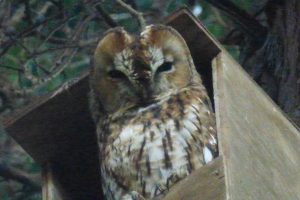Last year, 2014, was a good year for bird recording in the Botanics. 63 bird species were recorded during 2014. This is one more than 2013 and the same as in 2012. The two most frequently recorded species were Magpie (recorded on every possible recording day, a total of 264 days) and Wood Pigeon (recorded on 260 days out of a possible 264). Completing the top ten most frequently recorded birds were:
Carrion Crow (257 days out of 264)
Blackbird (250)
Moorhen (249)
Chaffinch (244)
Mallard (243)
Robin (243)
Bullfinch (240) and
Great Tit (227).
All of these may be expected on any visit to the Garden.
Two completely new species were added to the Garden’s current bird list in 2014: Cuckoo in May and Nuthatch in June (also in July). Separate blog entries were posted on Botanics Stories about these at the time and can still be read (Cuckoo: http://stories.rbge.org.uk/archives/11536; Nuthatch: http://stories.rbge.org.uk/archives/11832). Another addition to the current list was Fulmar, one of which flew over in June, the first to do so for very many (at least 15?) years. Fulmar was accordingly promoted to the main list from a separate list of historic bird records (earlier than 1997 when the current list was started). These three additions brought the Garden’s current (post-1997) bird list up from 87 to 90. Some of the species in the historic bird list still remain to be re-found in (or over) the Garden. When, for instance, will we see Water Rail, Short-eared Owl, or Coot in the Garden again? Of those, perhaps Coot is the most likely as they are resident at Inverleith Pond just across the road – why they never seem to come over to the Garden’s Pond nowadays is a mystery.
Other highlights of the year included Waxwings on 2 January, Goosander on the Pond in February and December, a Pheasant in April (including a predated egg!), Garden Warbler and Green Woodpecker in May, Raven in September, Woodcock in October and Dabchick (= Little Grebe) in November. Seven species were only recorded once in 2014: Common Gull, Cormorant, Cuckoo, Dabchick, Fulmar, Garden Warbler, Green Woodpecker, Rook, Waxwing and Woodcock.
Species that were recorded more often in 2014 than previous years are:
Herring Gull (up from 159 recording days in 2013 to 210 in 2014)
Greenfinch (up from 142 last year to 183)
Blue Tit (up from 143 days in 2012 to 206 in 2014)
Goldfinch (up from 102 last year to 141)
Song Thrush (up for a second year, from 92 to 108)
Chiffchaff (also up again, from 73 in 2013 to 94)
Blackcap (up from 28 days in 2012 to 64 in 2013 and 62 in 2014)
Kingfisher (back up last year, from 14 to 40, and seen almost daily so far in 2015)
Grey Wagtail (up from one day in 2012 to 18 in 2014, four more than last year).
Species seen less often in 2014 were far fewer than in 2013:
Feral Pigeon (well down, from 192 days in 2013 to 153 in 2014, and out of the top ten)
Collared Dove (back down to current ‘normal’ levels, from 40 days in 2013 to only 2 last year)
Many species that were seen less often in 2013 compared with 2012 were recorded more frequently again in 2014; these included Long-tailed Tit, Mistle Thrush and Stock Dove. However, House Sparrow, which had dipped to a single record in 2013 from five the previous year, was not recorded at all in 2014 – a far cry from when sparrows (and Starlings) were ubiquitous and numerous in the Garden in the 1970s and earlier. Also unrecorded in 2014 were Mute Swan (which was recorded on 61 days in 2012 and 14 in 2013), Fieldfare, Greylag Goose, Lesser Redpoll and Starling. Tawny Owl records were up from nil in 2012 and 22 days in 2013 to 32 records in 2014; an adult owl could often be seen sitting inside one of the Garden’s owl boxes. Two, or possibly three, owlets were also seen in the summer, indicative of breeding in the Garden for the first time for several years. There was also one Sparrowhawk nest in the Garden in 2014 in which six eggs were laid and four young fledged. Great Spotted Woodpeckers, Moorhen and Mallards also successfully raised young.
The full list of species recorded in 2014, in alphabetical order, is:
Blackbird, Blackcap, Black-headed Gull, Blue Tit, Bullfinch, Buzzard, Canada Goose, Carrion Crow, Chaffinch, Chiffchaff, Coal Tit, Collared Dove, Common Gull, Cormorant, Cuckoo, Curlew, Dabchick, Dunnock, Feral Pigeon, Garden Warbler, Goldcrest, Goldfinch, Goosander, Great Spotted Woodpecker, Great Tit, Greenfinch, Grey Heron, Grey Wagtail, Herring Gull, House Martin, Jackdaw, Kingfisher, Lesser Black-backed Gull, Long-tailed Tit, Magpie, Mallard, Mistle Thrush, Moorhen, Nuthatch, Oystercatcher, Pheasant, Pied Wagtail, Pink-footed Goose, Raven, Redwing, Robin, Rook, Siskin, Song Thrush, Sparrowhawk, Stock Dove, Swallow, Swift, Tawny Owl, Tree Creeper, Waxwing, Whooper Swan, Willow Warbler, Woodcock, Wood Pigeon, Wren.
Thanks to all the staff and other people who send me in records to augment my own daily observations and help to make the data more complete!


